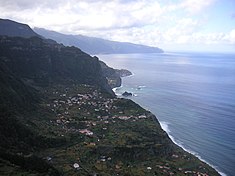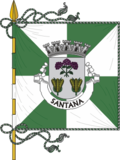Santana, Madeira Islands
| Santana | |||
| Municipality (Concelho) | |||
|
The village of Arco de São Jorge in an amphitheatre-shapped valley along the northern coast of Santana municipality
|
|||
|
|||
| Official name: Concelho da Calheta da Madeira | |||
| Country | |||
|---|---|---|---|
| Autonomous Region | |||
| Island | Madeira | ||
| Civil Parishes | Arco de São Jorge, Faial, Ilha, Santana, São Jorge, São Roque do Faial | ||
| Center | Santana | ||
| - elevation | 509 m (1,670 ft) | ||
| - coordinates | 32°48′13.45″N 16°52′47.30″W / 32.8037361°N 16.8798056°WCoordinates: 32°48′13.45″N 16°52′47.30″W / 32.8037361°N 16.8798056°W | ||
| Highest point | Pico Ruivo | ||
| - elevation | 1,862 m (6,109 ft) | ||
| - coordinates | 32°45′31″N 16°56′32″W / 32.75861°N 16.94222°W | ||
| Lowest point | Sea level | ||
| - elevation | 0 m (0 ft) | ||
| Area | 95.56 km2 (37 sq mi) | ||
| Population | 7,719 (2011) | ||
| Density | 81/km2 (210/sq mi) | ||
| Settlement | 25 May 1835 | ||
| - City | 6 July 2000 | ||
| LAU | Câmara Municipal | ||
| - location | Sítio do Serrado | ||
| President | António Joaquim Caíres Batista Rosa | ||
| Timezone | WET (UTC0) | ||
| - summer (DST) | WEST (UTC+1) | ||
| Postal Zone | 9230-116 | ||
| Area Code & Prefix | (+351) 291 XXX-XXXX | ||
| Demonym | Santanense | ||
| Patron Saint | Santa Ana | ||
| Municipal Holidays | 24 June | ||
|
Administrative location of Santana in the archipelago of Madeira
|
|||
| Website: http://cm-santana.com | |||
Santana (Portuguese pronunciation: [sɐ̃ˈtɐnɐ]), short form for Santa Ana (meaning Saint Anne) is a municipality along the northern coast of the island of Madeira, in Portuguese archipelago of the same name. The population in 2011 was 7,719, in an area of 95.56 square kilometres (36.90 sq mi).
Santana includes six parishes, within a rugged mountainous environment, most occupying river-valleys:
Santana parish has the largest number residents, while Arco de São Jorge is both the smallest, physically, and has the lowest number of residents, while Faial is the largest parish.
Santana is known for the traditional homes constructed with sloping triangular rooftops, and protected with straw. These were mainly rural homes, used by local farmers, during the settlement of the island, with white-painted walls, red doors and windows with blue trim. Most of the surviving buildings are tourist attractions, and maintained (for example, the straw roofs are replace every four to five years).
A tourist-themed park was constructed to exhibit examples of the island's early history and culture; the Madeira Theme Park is an ample area, on 7 acres (28,000 m2) of land, where visitors re-discover the cultures of Madeira and Porto Santo. This includes exhibits on the island's history, artifacts used in daily life and cultural presentations, in a scenic environment.
...
Wikipedia




